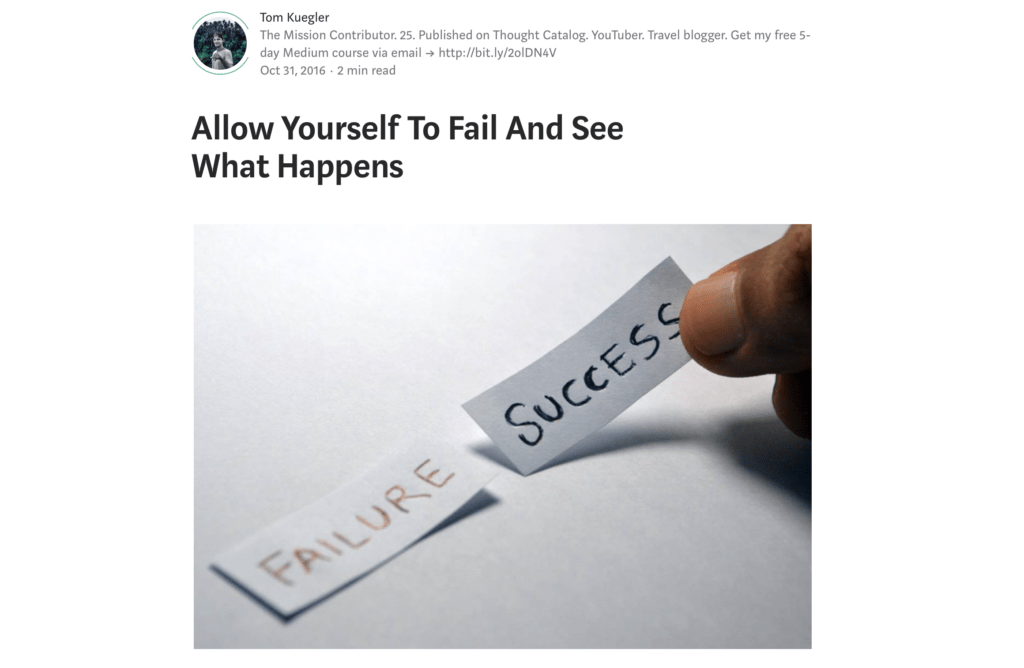How To Write Your First Blog Post In 60 Minutes

Writing your first blog post can be pretty daunting. As a writer with 50,000 followers on Medium, I know it’s easy to overthink how to write a compelling article.
So with that, I wanted to give you your first blog post template that’s easy, simple, and one that you’ll have finished within 60 minutes.
That’s right.
All you have to do is write a short 300-400 word post and then you’re done. I’d strongly consider publishing it on Medium if I were you.
Anyway, let’s start from the top..
Headline: Allow Yourself To _____________, And See What Happens
This is based off my own Medium article of the same name. Instead of being boring and writing about why you started a blog, why not just jump right into the thick of it?

Allow yourself to travel and see what happens.
Allow yourself to run every day and see what happens.
Allow yourself to be emotional and see what happens.
Just throw your own word in there that makes sense for what you want to write about. Also, DON’T WORRY, I’ll write an example article for you at the end of this.
DISCLAIMER: This article got a couple hundred views on the platform–it’s a good first blog post template!
The First 3 Paragraphs (The Introduction)
Here’s what my first 3 paragraphs looked like in the article itself:
“When I got out of college I met a wall of failure.
Literally I found somebody rejecting me everywhere I went. Because of this I started to develop a lot of animosity towards employers and older people in general.
I hated being told what I could and couldn’t do — so I started freelance writing. I had no bosses, I was my own!”
Here’s how to replicate them on your own..
Paragraph 1: When I [Insert experience here], I [failed/succeeded]
Paragraph 2: Give more details on what happened after that. (2-3 sentences)
Paragraph 3: Turning point. What you did in response to your experience. (1-2 sentences)
Paragraphs 4-6 (The Body)
The next 3 paragraphs basically just build on what your “turning point” was.
“However this wasn’t the end of my problems. Out on your own, especially in a field you know nothing about, you need to learn a ton of stuff quickly. I quite honestly had no clue what I was doing, so I started to reach out to people and ask questions.
I can’t tell you how nervous I was to hit the send button on those emails. They’re going to see I don’t know what I’m talking about. They won’t take me seriously, I thought. It was as if my entire life depended on sending this email or something. But you know what I realized?
It doesn’t freaking matter.”
The cool thing about storytelling is that nobody lives happily ever after. In your own life, you’ve made decisions that you thought would fix everything but you ended up still having problems.
Right?
The next three paragraphs are for you to tell everyone how your problems didn’t end there after the turning point.
Fourth Paragraph: This wasn’t the end of my problems, though. (3 sentences)
Fifth Paragraph: Building on what happened. (3-4 sentences)
Sixth Paragraph: Guess what? (1 sentence)
The Last 3 Paragraphs (Conclusion)
Now we have a proper story written. One with a turning point in Act 1 and then another turning point later on down the road (it wasn’t the end of your problems).
Now it’s time to wrap everything up in a bow. Tell us what you know now that you didn’t know before. What’s the lesson you learned going through all of this?
Spend the rest of this article building on what you learned in the end.
Here’s the last of my first blog post template.
“If someone makes you feel inferior for asking a dumb question, or even ignores you, then whatever, you know? There’s literally 7 billion people on this planet — chances are there’s someone out there who wants to help.
I realized that I needed to risk failing, or looking like a moron, to succeed. Fast forward a little bit, and I’m now writing at The Huffington Post just one year later. And guess what? I still cold email people all the time, and I’ve also found that most people look far superior than they actually are.
So go out there and fail. Ask dumb questions. Risk looking like an idiot, because I’ve found that most people won’t treat you bad at all, and will help you without asking for anything in return.”
Seventh Paragraph: Building on the “Big” lesson you learned in paragraph 6. (2-3 sentences)
Eighth Paragraph: Through this I realized _______, so _________. (3 sentences)
Ninth Paragraph: So go out there and __________. Lesson, lesson, lesson. Call to do! (3-4 sentences).
An Example Article Outline
Headline: Allow Yourself To Run Every Day And See What Happens
Paragraph 1: When I tried to run every day in 8th grade, I failed miserably.
Paragraph 2: (Talk about how I failed miserably in 8th grade).
Paragraph 3: But then in 9th grade, I strapped up my shoes and ran cross country… EVERY DAY!
Paragraph 4: This wasn’t the end of my running problems, though.
Paragraph 5: I was running every day, but I’d get sore, and I’d have to persevere through the pain even though every joint in my body wanted me to quit.
Paragraph 6: But guess what? That’s freakin' life!
Paragraph 7: Running every day was harder than I thought, and it got to a point where I achieved my goal, but wanted to quit cross country so bad.
Paragraph 8: But then I realized that it was giving me confidence, making me healthier, and it was actually kind of fun when I thought about it.
Paragraph 9: So get out there and give running every day a try! You’ll get to a point where running will be much, much easier for you, and you’ll gain a ton of confidence along the way. Good luck!
That’s All You Need
I hope you found this first blog post template useful. It should fit in nicely with anything you want to write about in your rookie blogging debut.